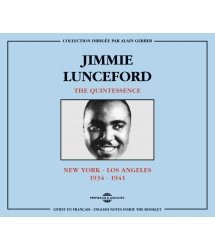“Cultural myths may obscure the facts. Pop historians like to maintain that the swing era began in August 1935 when Benny Goodman created a frenzy at the Palomar Ballroom in Los Angeles. But in May of that year, Jimmie Lunceford’s band had topped the hit parade with ‘Rhythm is our Business’, a massive hit that showed that the jitterbugs were already primed to explode. Indeed, throughout the Swing era, until his death in 1947, Lunceford was a major star, his band a byword for energy and style. Though an accomplished multi-instrumentalist and arranger, he exerted his influence on his men purely as a leader, the unquestioned arbiter of everything they did, from what they have played to how they looked. ‘The Harlem Express’, as it was known, was a formidable machine, a show-business juggernaut on a par with Duke Ellington, Count Basie and Benny Goodman. Discipline was part of the band’s DNA –Lunceford had formed it as a high-school teacher in Memphis, picking and polishing his best students to a series of successes, culminating in a residence at New York’s Cotton Club in 1934. The group enchanted audiences with its musical skills and its non-stop entertainment – vocals, comedy, dance routines – all from inside its ranks. Every detail was planned… As a sideman said, Lunceford even ‘checked their socks’. But the key was the music. The leader had an infallible instinct for taste and tempo, and a cast of premier arrangers, especially Sy Oliver, established the band’s unique sound – the two-beat rhythm dancers found irresistible, ingenious tone colours, the silky precision of the saxes, brass that could growl or go stratospheric. The band also boasted superb soloists, and an esprit de corps that was only thwarted by Lunceford’s refusal to pay proper salaries, leading to the reluctant departure of his stars. But The Quintessence, a 2-CD compilation on the Fremeaux label, displays the group at its many-sided best, when, as a brassman recalled, ‘in some places, even the walls would shake’.”
Par Geoffrey SMITH – BBC MUSIC MAGAZINE
Par Geoffrey SMITH – BBC MUSIC MAGAZINE











